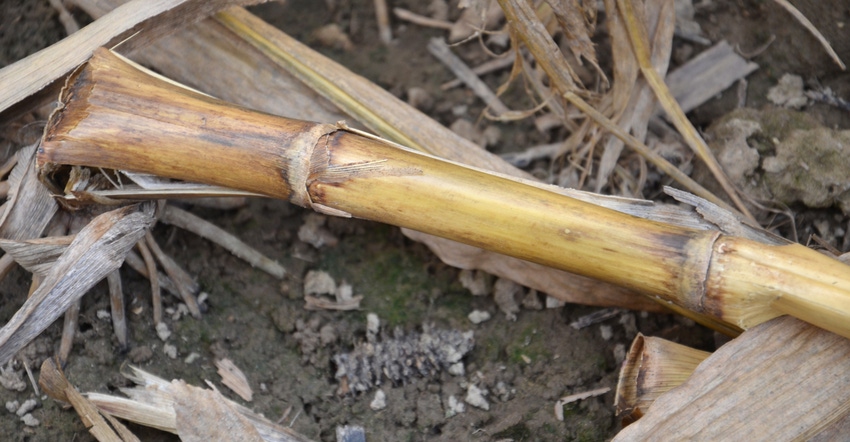July 23, 2019

Corn diseases didn’t have to wait for ideal planting weather. They were already “planted” in the ground, in the debris of previous crops. The disease triangle reminds us three things must be present for a disease epidemic: pathogen, susceptible host crop and environment suitable for spread of the pathogen.
Cooler, humid weather favors northern corn leaf blight, whereas hot and humid weather helps gray leaf spot. Watch for tar spot, a new disease that Purdue University and the University of Illinois scientists have alerted us about for the last couple of years. Anthracnose leaf blight can show up in hotter weather.
Recently, Illinois pathologists have reported common rust, which doesn’t survive on dead tissue and must be blown in from the South. Under the right conditions, cool and wet, it can cause lots of damage.
Stalk rots
More serious is anthracnose leaf blight and root and stalk rot. Anthracnose has become one of the dominant stalk rot diseases. This pathogen attacks roots and stalks of plants already weakened by leaf diseases.
Spores of this fungus can stay alive in the soil for a long time, especially, in corn after corn and no-till situations. This pathogen has plagued cornfields for many years and has been one of the biggest cornstalk killers the past few years.
Anthracnose can infect stalks when spores splash from the soil to lower stalk internodes. It makes shiny black spots on stalks that look like shoe polish. Stalks become black inside and can rot and fall over.
If conditions are conducive for diplodia and gibberella ear and stalk rot diseases, expect to see them. They also survive in the soil for many years.
Ear rots
Diplodia can infect ears, as well, usually starting at the base and spreading to the whole ear. Infected kernels are light in test weight but aren’t known to produce any toxins.
Gibberella ear rot is produced by a pink fungus that generally starts at the tips of ears.
Fusarium is another ear rot, which results in white-to-gray discoloration of groups of kernels or individual kernels scattered across the ear. There may also be a starburst pattern radiating out from the point of silk attachment.
According to the Purdue University Corn and Soybean Field Guide, both gibberella and fusarium can produce mycotoxins. Infected grain should be tested before feeding to livestock. Both diplodia and gibberella can cause lots of yield loss if corn isn’t harvested on time.
According to the Purdue guide, wet, humid conditions during silking and up to three weeks after silking favor these three ear rots.
Aspergillus, a fourth ear rot, is favored by hot, dry weather during the same period. Symptoms are masses of dusty olive-green spores on kernels. Aspergillus can produce aflatoxin, a powerful mycotoxin that can result in docks or rejection of corn at elevators.
Crop scouting starts at emergence and doesn’t end until the crop is binned. As the crop starts to mature, scout for ear and stalk rots by pulling back husks and pushing or pinching stalks. Plan which fields should be harvested first to reduce field losses.
Mother Nature wasn’t kind during the planting season this year. Let’s hope she extends the growing season and doesn’t favor diseases as harvest approaches.
Nanda is director of genetics for Seed Genetics-Direct, Jeffersonville, Ohio. Email him at [email protected] or call 317-910-9876.
About the Author(s)
You May Also Like






